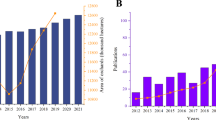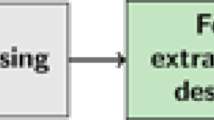Abstract
The objective of this study was to compare the slice image features of cucumbers preserved in different ways and fresh cucumbers. The models for discrimination of spontaneous lacto-fermented, pickled using a vinegar solution and fresh cucumber slices were built based on selected textures extracted from digital images converted to color channels L, a, b, R, G, B, U, V, X, Y, Z. The average accuracies were high of up to 98% for the Random Forest and Logistic classifiers for a model built based on textures selected from a set including textures from all color channels. The discrimination accuracies for individual samples were equal to 100% for fresh cucumber (Bayes Net, Logistic and IBk classifiers), 98% for vinegar-pickled cucumber (Random Forest, Logistic), 97% for lacto-fermented cucumber (Random Forest). The values of TP Rate, Precision, PRC Area, ROC Area and F-Measure were the highest for fresh cucumber and were equal to 1.000.



Similar content being viewed by others
References
Valverde-Miranda D, Díaz-Pérez M, Gómez-Galán M, Callejón-Ferre ÁJ (2021) Total soluble solids and dry matter of cucumber as indicators of shelf life. Postharvest Biol Technol 180:111603
Ariana DP, Lu R (2010) Hyperspectral imaging for defect detection of pickling cucumbers. In: Sun D-W (ed) Hyperspectral imaging for food quality analysis and control, Chapter 14. Elsevier Inc, Amsterdam, pp431–447
Mi S, Zhang X, Wang Y, Ma Y, Sang Y, Wang X (2022) Effect of different fertilizers on the physicochemical properties, chemical element and volatile composition of cucumbers. Food Chem 367:130667
Pan L, Zhou Ch, Jing J, Zhuang M, Zhang J, Wang K, Zhang H (2022) Metabolomics analysis of cucumber fruit in response to foliar fertilizer and pesticides using UHPLC-Q-Orbitrap-HRMS. Food Chem 369:130960
Sun Y, Zhao X, Ma Y, Guan H, Liang H, Wang D (2022) Inhibitory effect of modified atmosphere packaging on Escherichia coli O157:H7 in fresh-cut cucumbers (Cucumis sativus L.) and effectively maintain quality during storage. Food Chem 369:130969
Moore JF, DuVivier R, Johanningsmeier SD (2021) Formation of γ-aminobutyric acid (GABA) during the natural lactic acid fermentation of cucumber. J Food Compos Anal 96:103711
Stoll DA, Müller A, Meinhardt AK, Dötsch A, Greiner R, Kulling SE, Huch M (2020) Influence of salt concentration and iodized table salt on the microbiota of fermented cucumbers. Food Microbiol 92:103552
Fideler J, Johanningsmeier SD, Ekelöf M, Muddiman DC (2019) Discovery and quantification of bioactive peptides in fermented cucumber by direct analysis IR-MALDESI mass spectrometry and LC-QQQ-MS. Food Chem 271:715–723
McMurtrie EK, Johanningsmeier SD (2018) Quality of cucumbers commercially fermented in calcium chloride brine without sodium salts. J Food Qual 8051435:1–13
de Matos AD, Marangon M, Magli M, Cianciabella M, Predieri S, Curioni A, Vincenzi S (2019) Sensory characterization of cucumbers pickled with verjuice as novel acidifying agent. Food Chem 286:78–86
Johanningsmeier SD, McFeeters RF (2013) Metabolism of lactic acid in fermented cucumbers by Lactobacillus buchneri and related species, potential spoilage organisms in reduced salt fermentations. Food Microbiol 35:129–135
Pérez-Díaz IM, Hayes JS, Medina E, Webber AM, Butz N, Dickey AN, Lu Z, Azcarate-Peril MA (2019) Assessment of the non-lactic acid bacteria microbiota in fresh cucumbers and commercially fermented cucumber pickles brined with 6% NaCl. Food Microbiol 77:10–20
Johanningsmeier SD, McFeeters RF (2015) Metabolic footprinting of Lactobacillus buchneri strain LA1147 during anaerobic spoilage of fermented cucumbers. Int J Food Microbiol 215:40–48
Daughtry KV, Johanningsmeier SD, Sanozky-Dawes R, Klaenhammer TR, Barrangou R (2018) Phenotypic and genotypic diversity of Lactobacillus buchneri strains isolated from spoiled, fermented cucumber. Int J Food Microbiol 280:46–56
Sabanci K, Aslan MF, Ropelewska E, Unlersen MF (2021) A convolutional neural network-based comparative study for pepper seed classification: analysis of selected deep features with support vector machine. J Food Process Eng e13955. https://doi.org/10.1111/jfpe.13955
Nosratabadi S, Ardabili S, Lakner Z, Mako C, Mosavi A (2021) Prediction of food production using machine learning algorithms of multilayer perceptron and ANFIS. Agriculture 11:408
Sabanci K, Aslan MF, Durdu A (2020) Bread and durum wheat classification using wavelet based image fusion. J Sci Food Agric 100(15):5577–5585
Pourdarbani R, Sabzi S, Kalantari D, Arribas JI (2020) Non-destructive visible and short-wave near-infrared spectroscopic data estimation of various physicochemical properties of Fuji apple (Malus pumila) fruits at different maturation stages. Chemometr Intell Lab Syst 206:104147
Kheiralipour K, Pormah A (2017) Introducing new shape features for classification of cucumber fruit based on image processing technique and artificial neural networks. J Food Process Eng 40(6):e12558
Clement J, Novas N, Gazquez JA, Manzano-Agugliaro F (2013) An active contour computer algorithm for the classification of cucumbers. Comput Electron Agric 92:75–81
Sabzi S, Pourdarbani R, Rohban MH, García-Mateos G, Arribas JI (2021) Estimation of nitrogen content in cucumber plant (Cucumis sativus L.) leaves using hyperspectral imaging data with neural network and partial least squares regressions. Chemometr Intell Lab Syst 217:104404
Ropelewska E, Mieszczakowska-Frąc M, Kruczyńska D (2022) The evaluation of the usefulness of textures from cross-section images obtained using a digital camera and a flatbed scanner for cultivar discrimination of quince (Cydonia oblonga Mill.). Food Control 131:108447
Szczypiński PM, Strzelecki M, Materka A, Klepaczko A (2009) MaZda—a software package for image texture analysis. Comput Methods Programs Biomed 94(1):66–76
Bouckaert RR, Frank E, Hall M, Kirkby R, Reutemann P, Seewald A, Scuse D (2016) WEKA manual for version 3-9-1. University of Waikato, Hamilton
Frank E, Hall MA, Witten IH (2016) The WEKA Workbench. Online appendix for data mining: practical machine learning tools and techniques, Morgan Kaufmann, 4th edn
Witten IH, Frank E (2005) Data mining: practical machine learning tools and techniques (525), 2nd edn. Elsevier, San Francisco
Ropelewska E (2020) The use of seed texture features for discriminating different cultivars of stored apples. J Stored Prod Res 88:101668
Ropelewska E (2021) The application of machine learning for cultivar discrimination of sweet cherry endocarp. Agriculture 11:6
Ropelewska E, Rutkowski KP (2021) Differentiation of peach cultivars by image analysis based on the skin, flesh, stone and seed textures. Eur Food Res Technol 247:2371–2377
Sabanci K, Aslan MF, Ropelewska E, Unlersen MF, Durdu A (2022) A novel convolutional-recurrent hybrid network for sunn pest-damaged wheat grain detection. Food Anal Methods. https://doi.org/10.1007/s12161-022-02251-0
Koklu M, Unlersen MF, Ozkan IA, Aslan MF, Sabanci K (2021) A CNN-SVM study based on selected deep features for grapevine leaves classification. Measurement 188:110425
Liu Z, He Y, Cen H, Lu R (2018) Deep feature representation with stacked sparse auto-encoder and convolutional neural network for hyperspectral imaging-based detection of cucumber defects. Trans ASABE 61(2):425–436
Lu Y, Lu R (2021) Detection of chilling injury in pickling cucumbers using dual-band chlorophyll fluorescence imaging. Foods 10:1094
Ariana DP, Lu R (2010) Evaluation of internal defect and surface color of whole pickles using hyperspectral imaging. J Food Eng 96:583–590
Lu Y, Lu R, Zhang Z (2021) Detection of subsurface bruising in fresh pickling cucumbers using structured-illumination reflectance imaging. Postharvest Biol Technol 180:111624
Lu R, Ariana DP (2013) Detection of fruit fly infestation in pickling cucumbers using a hyperspectral reflectance/transmittance imaging system. Postharvest Biol Technol 81:44–50
Mao S, Li Y, Ma Y, Zhang B, Zhou J, Wang K (2020) Automatic cucumber recognition algorithm for harvesting robots in the natural environment using deep learning and multi-feature fusion. Comput Electron Agric 170:105254
Ma J, Du K, Zheng F, Zhang L, Gong Z, Sun Z (2018) A recognition method for cucumber diseases using leaf symptom images based on deep convolutional neural network. Comput Electron Agric 154:18–24
Lin K, Gong L, Huang Y, Liu C, Pan J (2019) Deep learning-based segmentation and quantification of cucumber powdery mildew using convolutional neural network. Front Plant Sci 10:155
Liu Ch, Zhu H, Guo W, Han X, Chen Ch, Wu H (2021) EFDet: an efficient detection method for cucumber disease under natural complex environments. Comput Electron Agric 189:106378
Author information
Authors and Affiliations
Corresponding author
Ethics declarations
Conflict of interest
There are no conflicts to declare.
Compliance with ethics requirements
This article does not contain any studies with human or animal subject.
Additional information
Publisher's Note
Springer Nature remains neutral with regard to jurisdictional claims in published maps and institutional affiliations.
Rights and permissions
About this article
Cite this article
Ropelewska, E., Sabanci, K. & Aslan, M.F. Preservation effects evaluated using innovative models developed by machine learning on cucumber flesh. Eur Food Res Technol 248, 1929–1937 (2022). https://doi.org/10.1007/s00217-022-04016-9
Received:
Revised:
Accepted:
Published:
Issue Date:
DOI: https://doi.org/10.1007/s00217-022-04016-9




